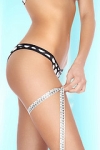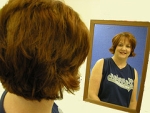Tackling Problem Areas Of Your Body

Very few people are able to say honestly that they are totally happy with their body. Everyone has at least one gripe – if it is not big feet, it is thin hair or knobbly knees. All these perceived “flaws” cam be improved or disguised, but as anyone who has ever tried (and failed) to move the fat that sits on strategic points such as hips, thighs, stomachs and buttocks knows, it is much easier to hide the flaws than to tackle them. Trouble spots such as these are notoriously stubborn to shift, but it is possible to alter your outline with a combination of diet and exercise.

Common Problem Areas:
Any of the following can be discouraging, but remember – each problem has a solution.
Slack Stomachs: Our stomachs become flabby when the abdominal muscles slacken; this usually happens through lack of exercise. Your abdomen extends from just under the bustline to the groin, and it is packed with muscles that criss-cross to form a wall to hold the abdominal contents in place – a bit like a corset. Exercise is not the only way to keep your stomach flat though: weight is also an important factor and the long-term answer is both diet and exercise.
Thunder Thighs: Like bottoms and busts, thighs are a great source of discontent, whether it is because they are too flabby, muscular or skinny. You inherit the basic shape of your thighs, but that does not necessarily mean that you were born with the excess fat that may be covering them. Thigh size and tone can certainly be altered with the right diet, correct body care and regular exercise. Sports such as cycling, skiing, tennis, squash and riding (a great inner-muscle firmer) will tone your thighs, as will weight-training for specific areas of the body.
Large Bottoms: There are three large muscles in our buttocks : gluteus maximus, medius and minimus. These create the shape, but not the size of our rear ends. It is the tone of these muscles and the fatty tissue around them that give us the bottoms we have. The good news is that buttock muscles respond well to exercise, which means that any effort you put into bottom-toning exercises will be rewarded quite quickly. Locomotive exercises – such as fast wall king, running upstairs and jogging are especially good bottom trimmers. Other exercises are given in the Exercises for Specific Problems.

Slack Upper Arms: Arms do not really change shape a great deal during our lives, unless we lose or gain a lot of weight. Muscle tone is the main problem, but, as in the case of thighs, exercise and specific weight-training will tone up and reshape flabby arms. It is very often the case that any changes in body shape that happen through exercise and diet are noticeable more quickly on your upper arms.
Droopy Breasts: Breast shape and size only really change when our weight swings dramatically, during pregnancy, breast feeding, menstruation, or if taking oral contraceptives. Gravity is the bust’s worst enemy, especially if the breasts are not given proper support, because it literally drags the breasts down and slackens their tone. Although the breasts are supported by suspensory ligaments, they do not contain any muscle (the milk glands are buffered by protective fatty tissue) so you cannot noticeably reverse lost tone. However, if you exercise the pectoral muscles beneath your armpits you will give your breasts a firmer base and more uplift.
Thick Ankles: Trim and slender ankles are seen to be a great asset. But if you are not blessed with these, or if your ankles tend to become stiff and puffy from fluid retention, you need to brush up on some ankle-improving exercises. Access the flexibility of your ankles by sitting on a chair or stool with your feet on the floor and , while keeping your heel down pull the rest of your foot up as far as it will go: if the distance between your foot and the floor measures 12-15cm/5-5in your joint flexibility is good; if it is between 10-12cm/4-4in it is fair; and if it is less than that, your joint flexibility is poor.

Improving Your True Form:
Obviously there are certain things about your body shape that you will never be able to change. However, it is important to focus on your good points and remember that there is a great deal you can do to improve on your natural shape and form. Confront Your Body: Go on, be brave. Strip to your underwear, stand in front of a mirror and have a good look at your body. Take your time and be tough but realistic. You may have disliked your thighs since you were 16 – and they will probably never be those of a super model – but if you look hard enough you might just find that they are not as bad as you have always thought, and that improving them is not going to be that hard after all.
Write It All Down: Note down all the things that annoy you (and that you can do something about) as well as those that you like or do not mind. Then go through your list of dislikes, ticking the things that you really want to do something about. Also, make a mental note to start appreciating your good points: the more you focus on them the less you will notice the not-so-good zones.

Make An Action Checklist: Add a set of action points under the problem zones you have listed. If you want to firm up your arms for that sleeveless sundress you have been unable to wear for a decade of summers, make notes like this:
flabby Upper Arms
Do Basic Exercises
Check Diet
Exfoliate/moisture
Finally, add your goal(s) and your deadline to the top of the list and put it somewhere where you are going to see it frequently.